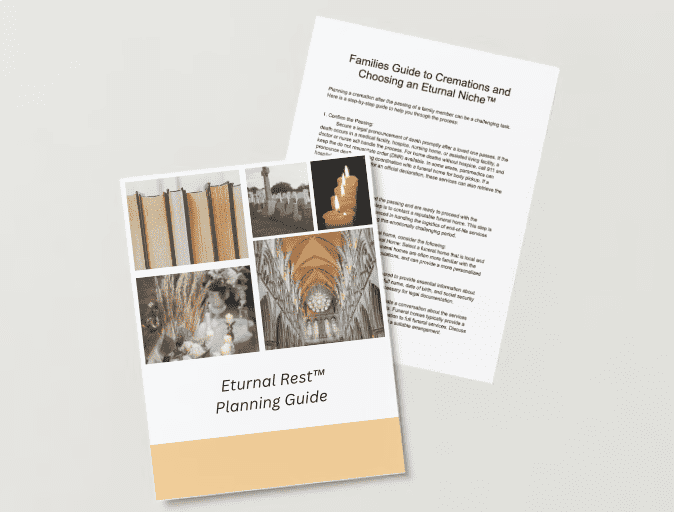Planning Ahead
Planning Ahead
Pre-planning involves making choices and organizing details for cemetery, burial, memorial, and funeral arrangements before someone passes away. These combined arrangements are termed “final arrangements” and cover various elements like burial type, location, funeral service specifics, and lasting memorials.
Final arrangement plans can be made in good health, during illness, or after death. Advanced pre-planning occurs well in advance, while imminent need pre-planning is for a relatively soon passing. Plans made post-death are termed at-need plans.
The pre-planning process is both educational and decision-oriented. It starts with gathering information about available options. With this information, decisions can be made to balance value and cost. Once decisions are made, a plan is created to document and share these choices with next-of-kin, family, and friends. If purchases are part of pre-planning, written agreements and guarantees are provided by the cemetery, funeral home, or memorial supplier. Pre-planning doesn’t necessarily involve pre-purchasing. If decisions are made without purchases, pre-planning should result in a clear, well-documented record of an individual’s wishes and choices.
Purpose of Pre-Planning
The purpose of pre-planning for death is to thoughtfully and proactively make decisions about one’s end-of-life arrangements before the actual event occurs. This process serves several important purposes:
Personalization of End-of-Life Preferences: Pre-planning allows individuals to express their specific wishes regarding funeral services, burial or cremation, and other related details. This ensures that their preferences are known and honored.
- Relieving Family Burden: By making decisions in advance, individuals ease the emotional burden on their family members who would otherwise have to make these choices during a challenging and emotional time.
- Financial Preparedness: Pre-planning can involve setting aside funds or arranging for financial coverage to address funeral expenses. This helps in managing costs and alleviates financial stress for surviving family members.
- Legal and Administrative Clarity: Pre-planning involves organizing important legal documents such as wills, trusts, and powers of attorney. This ensures that the legal and administrative aspects are well-documented and in order.
- Ensuring Cultural or Religious Observances: Individuals can specify their cultural or religious preferences for end-of-life ceremonies, ensuring that these important aspects are respected and incorporated into the final arrangements.
- Reducing Disputes: Clear documentation of one’s wishes can help prevent potential disagreements among family members about the appropriate course of action, leading to a smoother and more harmonious process.
- Peace of Mind: Pre-planning provides individuals with a sense of control and peace of mind, knowing that their wishes will be followed, and their loved ones will be supported during a difficult time.
The purpose of pre-planning for death is to facilitate a more organized, personalized, and less stressful transition, both for the individual and their surviving family members.

Families Guide to Cremations and Choosing an Eturnal Niche™
Pre-Planning Checklist
Creating a pre-planning checklist for end-of-life arrangements involves considering various aspects to ensure that one’s preferences are documented and communicated. Here’s a comprehensive pre-planning checklist:
1. Funeral Preferences:
- Decide on the type of funeral service (traditional, memorial, celebration of life).
- Specify preferred location and details of the service.
- Choose between burial and cremation.
2. Cemetery and Burial Preferences:
- Select an Eturnal Columbarium™ and reserve an Eturnal Niche™
- Select a cemetery and burial plot if opting for burial.
- Outline preferences for a headstone or marker.
3. Cremation Details:
- Specify what should be done with the ashes (e.g., scattering, keepsake urn).
- Decide on the location for any ash-scattering ceremony.
4. Legal and Financial Documents:
- Ensure wills, trusts, and powers of attorney are up-to-date.
- Organize life insurance policies and relevant financial documents.
5. Notification and Communication:
- Compile a list of important contacts for family and friends.
- Share your end-of-life wishes with loved ones.
6. Cultural or Religious Preferences:
- Outline any specific cultural or religious rituals or observances.
7. Memorialization:
- Decide on permanent memorialization, such as plaques, benches, or charitable contributions.
- Creating an Eturnal Tribute™
8. Financial Considerations:
- Explore funding options for funeral expenses.
- Consider setting aside funds or obtaining funeral insurance.
9. Personal Belongings:
- Specify any personal items you wish to be included in the funeral or passed on to specific individuals.
10. Digital Accounts:
- Document usernames and passwords for digital accounts.
- Specify wishes for online presence or memorialization.
11. Funeral Home and Director:
- Choose a funeral home and establish contact with a funeral director.
- Discuss pre-payment options if applicable.
12. Advance Care Directives:
- Document preferences for end-of-life medical care.
- Appoint a healthcare proxy if necessary.
13. Organ Donation:
- Specify wishes regarding organ and tissue donation.
14. Review and Update:
- Periodically review and update your pre-planning documents to ensure they reflect current preferences.
15. Communicate with Professionals:
- Discuss your plans with legal professionals, financial advisors, and funeral planning experts.
It’s crucial to involve loved ones in the discussion and ensure that the relevant documents are easily accessible to them when needed. Regularly revisiting and updating the checklist is also important to account for any changes in preferences or circumstances. It’s also important to note that the process of planning for a death in the family can be complex and may involve additional steps depending on your individual circumstances. Consider consulting with a professional or reaching out to resources in your community for guidance and support.
Make an order
Other Planners

What is Lorem Ipsum?
Whether you want to write a letter, share a favorite memory or simply provide a listening ear to someone who has suffered a loss, the most important thing is to be heartfelt.

Where does it come from?
It can be hard to know what to say to someone who is grieving. It’s easy to feel like there are no words that will truly offer solace, but simply saying, “I’m here for you,” or “I’m so sorry,” can be enough.
